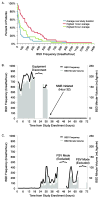Quantifying unintended exposure to high tidal volumes from breath stacking dyssynchrony in ARDS: the BREATHE criteria
- PMID: 27342819
- PMCID: PMC4992404
- DOI: 10.1007/s00134-016-4423-3
Quantifying unintended exposure to high tidal volumes from breath stacking dyssynchrony in ARDS: the BREATHE criteria
Abstract
Purpose: Breath stacking dyssynchrony generates higher tidal volumes than intended, potentially increasing lung injury risk in acute respiratory distress syndrome (ARDS). Lack of validated criteria to quantify breath stacking dyssynchrony contributes to its under-recognition. This study evaluates performance of novel, objective criteria for quantifying breath stacking dyssynchrony (BREATHE criteria) compared to existing definitions and tests if neuromuscular blockade eliminates high-volume breath stacking dyssynchrony in ARDS.
Methods: Airway flow and pressure were recorded continuously for up to 72 h in 33 patients with ARDS receiving volume-preset assist-control ventilation. The flow-time waveform was integrated to calculate tidal volume breath-by-breath. The BREATHE criteria considered five domains in evaluating for breath stacking dyssynchrony: ventilator cycling, interval expiratory volume, cumulative inspiratory volume, expiratory time, and inspiratory time.
Results: The observed tidal volume of BREATHE stacked breaths was 11.3 (9.7-13.3) mL/kg predicted body weight, significantly higher than the preset volume [6.3 (6.0-6.8) mL/kg; p < 0.001]. BREATHE identified more high-volume breaths (≥2 mL/kg above intended volume) than the other existing objective criteria for breath stacking [27 (7-59) vs 19 (5-46) breaths/h; p < 0.001]. Agreement between BREATHE and visual waveform inspection was high (raw agreement 96.4-98.1 %; phi 0.80-0.92). Breath stacking dyssynchrony was near-completely eliminated during neuromuscular blockade [0 (0-1) breaths/h; p < 0.001].
Conclusions: The BREATHE criteria provide an objective definition of breath stacking dyssynchrony emphasizing occult exposure to high tidal volumes. BREATHE identified high-volume breaths missed by other methods for quantifying this dyssynchrony. Neuromuscular blockade prevented breath stacking dyssynchrony, assuring provision of the intended lung-protective strategy.
Keywords: Acute lung injury; Acute respiratory distress syndrome; Mechanical ventilation; Patient–ventilator dyssynchrony; Respiratory mechanics; Ventilator-induced lung injury.
Conflict of interest statement
On behalf of all authors, the corresponding author states that there is no conflict of interest.
Figures


Comment in
-
The BREATHE-appeal: harmonize interaction between patient and ventilator!J Thorac Dis. 2016 Dec;8(12):E1647-E1650. doi: 10.21037/jtd.2016.12.35. J Thorac Dis. 2016. PMID: 28149604 Free PMC article. No abstract available.
-
Detection of patient-ventilator asynchrony should be improved: and then what?J Thorac Dis. 2016 Dec;8(12):E1661-E1664. doi: 10.21037/jtd.2016.12.101. J Thorac Dis. 2016. PMID: 28149608 Free PMC article. No abstract available.
References
-
- Kallet RH, Alonso JA, Diaz M, et al. The effects of tidal volume demand on work of breathing during simulated lung-protective ventilation. Respir Care. 2002;47:898–909. - PubMed
Publication types
MeSH terms
Grants and funding
LinkOut - more resources
Full Text Sources
Other Literature Sources
Medical

